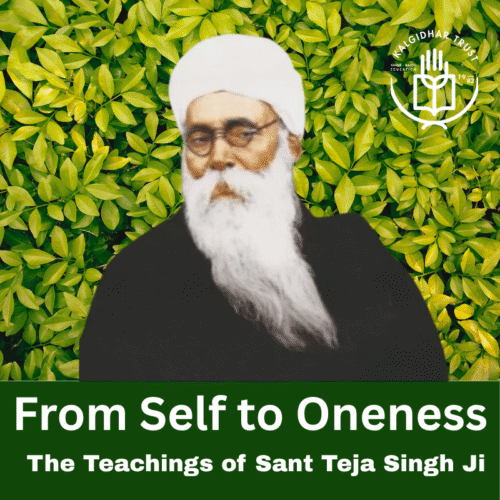A Journey from Oneness to Inner Awakening — Recap of Part 1 and 2
In Part 1, we explored how Sant Teja Singh Ji, a saint-scholar of the modern era, delivered a compelling message of Science and Spirituality at the World Congress of Religions for World Peace, Japan, 1956, emphasizing Ik Onkar — Oneness of the Divine.
In Part 2, we unfolded his powerful discourse on how saints like Guru Arjan Dev Ji and revered Bhagats from various faiths embodied the message of unity beyond caste, creed, and religion — teaching us that God lives within all.
Now in Part 3, we unlock the most profound wisdom — the science of meditation, the human mind, the time, the method, and the life-changing effects of Naam Simran (meditation on the Divine Name).
On the Barsi of Sant Teja Singh Ji (3rd July)
Let’s honor this divine soul by applying his teachings:
- Begin or deepen your daily meditation practice.
- Spread the message of unity and love.
- Inspire others to look within — where the Eternal Divine resides.
Imagine a world where swords turn into ploughshares, hate into harmony, chaos into peace. That world begins with you. With us. With this moment.
Let’s make this Barsi not just a remembrance — but a rebirth of Sant Teja Singh Ji’s mission for Oneness.
Missed the earlier parts? Catch up here:
Part 1: Sant Teja Singh Ji – Merging Intellect With Inner Light.
Part 2: Realizing Oneness — Lessons from Saints Across Faiths
The Blueprint for Global Peace — Sant Teja Singh Ji’s Universal Message
“All faiths, all paths — when centered on the Divine Name — lead to unity, harmony, and peace.”
- Whether you chant Om, Waheguru, Allah, God, or any Divine Name — the essence is the same.
- When humanity embraces this truth, the world transforms:
- Hatred turns into love.
- Violence transforms into service.
- Boundaries of religion dissolve into spiritual kinship.
Why the Time of Meditation Matters – The Power of Amrit Vela
Guru Nanak Dev Ji and all spiritual masters emphasized a sacred time for meditation — the Amrit Vela, or the hours before sunrise (approximately between 3:00 AM and 6:00 AM).
Why meditate before sunrise?
- Silence of the Universe: The world is at rest. The noise of the day is absent. Nature itself is attuned to the Divine vibration.
- Purity of Cosmic Vibrations: Negative energies of worldly desires are dormant. Positive vibrations from meditators worldwide uplift the seeker.
- Mental Freshness: After a night’s rest, the mind is clear, calm, and more receptive to spiritual practice.
- Foundation for the Day: Starting the day in remembrance of the Divine strengthens the mind, enhances emotional balance, and shields against stress, anger, and temptation.
“The peace of mind gained during Amrit Vela sustains you through the chaos of the day.”
The Method of Meditation — Simple Yet Divine
Sant Teja Singh Ji explained that the path to the Divine is simple but requires discipline and sincerity.
Step-by-Step Process:
Choose a Name of the Divine:
Whether it’s Waheguru, Ram, Allah, Om, God, or any name that resonates — all lead to the same Supreme Light.
Sit in a Stable, Relaxed Posture:
Cross-legged, spine upright, hands resting comfortably — a posture of alert relaxation.
Close Your Eyes. Center Your Focus.
Chant the Name Slowly, Lovingly:
Let it vibrate through your entire being — mentally and softly aloud. Focus deeply on the sound and its meaning.
Breathe Naturally.
Keep Bringing the Mind Back:
When it wanders (and it will), gently guide it back to the sound of the Name.
Finish with Gratitude and Prayer.
Then Engage in Congregational Singing (Kirtan), Prayer, and Reading Divine Wisdom (Gurbani or Holy Texts).
“Naam Simran isn’t merely chanting — it’s merging your soul into the ocean of the Divine.”
The Science Behind Naam — How It Transforms the Mind
How does it work?
Just as soap cleanses clothes, Naam (Divine Name) cleanses the mind from impurities like:
- Lust
- Anger
- Greed
- Attachment
- Ego
These are the clouds that block the inner sunlight of the soul. With regular practice:
- The veil of ignorance lifts.
- The Divine Light within starts to shine.
- The seeker begins to see God in every being — no enemies, no strangers, only love and kinship.
- The mind becomes balanced, resilient, and peaceful.
Guru Nanak Dev Ji beautifully describes this process in Japji Sahib:
“Bharyai mat paapaan kay sang, oh dhoapai naavai kay rang.”
(“When the mind is soiled with sins, it can only be cleansed by washing it with the colour of the Divine Name.”)
















Add comment